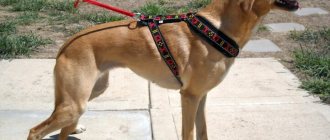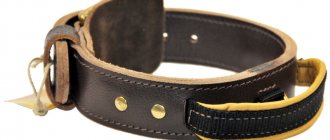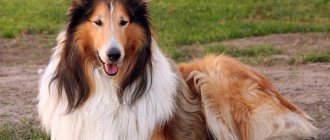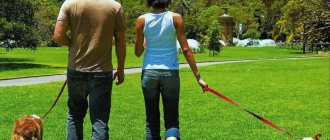Why do you need such a collar?
It's quite common for dogs to ignore standard collars when it comes to training. This problem especially worries owners of large breed dogs. The parfors is worn solely for the purpose of training the dog, that is, it is not a permanent collar. Over time, the dog gets used to obeying the owner’s commands on the leash, so it is transferred to a softer training – a noose leash. In order to achieve maximum effect and not injure your pet, you need to know some rules that will help you avoid mistakes in using such a collar.
Can a dog collar be used on puppies?
The main use of parfors is training or correcting the behavior of complex, aggressive, overly energetic, large breeds.
The largest dogs in the world are: Deerhound, Leonberger, Newfoundland, Tibetan Mastiff, Irish Wolfhound, Great Dane, St. Bernard and Alabay.
In principle, this is an exhaustive list for its application. It does not apply to a number of medium and small breeds of our smaller brothers, to pets with good training ability, to puppies of different breeds.
Experienced trainers recommend the use of parforce during the educational process of your pet. The main thing is to consult with a good specialist and do everything correctly. Then you will not cause any harm to the animal and will facilitate the training process.
Rules of use:
- use a collar that fits snugly around your pet's neck
- parfors is located as close to the ears as possible
- The planer should not be used constantly, otherwise it becomes addictive
- during educational work, use jerks on the leash, but do not let the dog constantly pull on the leash (promotes habituation and does not bring results)
- if the dog behaves well on the grinder, then you need to switch to a softer method of training
- The dog must get used to the strict collar
Proper use of a safety collar will not be beneficial if you do not choose the right collar for a particular dog. To choose the right parfors, you need to briefly familiarize yourself with the types of strict collars and choose the one that suits you.
How to choose the right collar
Foreign models of parfors are assembled in such a way that they can be put on only by uncoupling the links. Our models allow you to wear them over your head.
When purchasing a collar, check that all the links are well connected and do not come apart when jerked. It's also worth checking the length.
Important! Put a collar on your dog before a walk - this will neutralize the negative perception of the animal.
A short one will be difficult and traumatic to put on an animal, and a long collar will most likely be easy for the dog to take off. And you also need to know that this type of collar is classified by weight:
- easy;
- average;
- heavy.
And therefore, the best choice will be made with fitting and correct, professional fitting of the parforce.
How to choose a size
The golden rule when choosing a regular leather collar is that it should have +5 cm to the circumference of your pet's neck.
When choosing a planer, the rule remains the same, only the volume of the neck should be measured slightly below the ears. Because the correct location of the collar is high on the neck, almost under the throat.
What should be the length of the spikes
The length of the spikes, the material from which they are made, and the angle at which they are located on the collar depend on the manufacturer and model. Models are developed taking into account the weight of the animal and the breed of the dog (smooth-haired or breeds with abundant thick hair).
Now they practice parfors with spikes, the ends of which are covered with rubber tips . The effect of educational discomfort remains, and the model is very convenient for those active breeds that strive to slip out of the collar.
Types of collars (parfors)
The material of a strict collar is not of serious importance, although it varies. Parfors are mainly divided into two types - wire and plate. A strict collar can be covered with leather. The length of the spikes also varies. For dogs with short hair, a collar with short spikes is suitable, while for dogs with long, thick hair, it is better to take a strict collar with long spikes. Parfors is also divided by weight.
What does parfors for dogs look like and what is it made from?
Parfors is a chain consisting of links. They can be made from:
- of stainless steel;
- ferrous metal;
- various alloys;
- chrome steel.
Whatever the material, it must be very durable. Collars made of thin thin metal that bend in the hands of the owner are unacceptable. The spikes on the collar should apply pressure to your pet's skin, not puncture it. When purchasing, you should take a closer look at the fact that they should be bent.
Links are typically added and subtracted based on size (the thickness of the dog's neck). Some models do not provide for disassembly into links; it is better to abandon them. Each link has spikes directed towards the animal’s neck at a certain angle.
Collars are:
- lamellar. The spikes on them are short and are not suitable for long-haired dogs. The model is also not suitable for very large dogs; they bend easily;
- wire These models are the most popular. The spikes have different lengths and directions.
Conclusion
If parfors is used correctly, it will not harm the dog. However, you should not buy or use such a collar without a good reason. Parfors is used only when the dog does not respond to the owner’s commands. Using it in training puppies and small breeds of dogs is a bad idea. When using parforce, do not forget that if there is no patience during training and the adequacy of commands, the dog will lose contact with the owner even faster and feel self-doubt. Be careful when making such purchases.
Briefly about the purpose
Planer, or parfors, is equipment that is used for training large or hyperactive breeds of dogs . It allows you to train your pet and correct the aggressive behavior of complex breeds.
Did you know? Dog collars have been used since the ancient world. So, for example, in the 9th century. BC. The Chaldeans, who noticeably did not get along with Babylon, used swift and powerful dogs when attacking, wearing heavy metal collars with sharp curved knives.
These are metal links, inside of which there are spikes with rounded teeth, and they are located at an angle to minimize possible injury to the animal. Usually the end of the collar is not fastened, but passed through a ring.
When pulled, it tightens and the spikes impact the dog's neck. As soon as the animal takes the correct position, the tension weakens, the ends separate, and the discomfort disappears.
Video: features of using a strict collar in training
When teaching a pet a certain command, for example: “near” or “fu”, the trainer/owner sharply pulls the leash, and the spikes with a certain force compress the animal’s neck, forcing it to obey.
The strength of the jerk and the frequency of use depend on the pet’s learning ability and are used at the discretion of the owner.
A seemingly formidable device will become an instrument of torture only for a cruel owner; for a professional, it will serve as an effective simulator.
It is considered correct to use it for a short period of time while the issue is being resolved. This is not a panacea if the dog is undertrained and does not accept commands. It is precisely the constant wearing of parfors by a dog that characterizes a lazy owner.
Rules for using the planer
The first rule of using a planer is that it should not be worn for a long time. Only during training and if there is a need to correct the dog’s incorrect behavior during a walk . Increase the jerk force as needed. If your pet behaves well during training, this is the first signal that you need to get rid of the bully. Look for your “golden rule” of application, feel your student.
The dog should not get used to following commands only in parforce. And the dog should not, in principle, get used to the discomfort of the collar, otherwise the entire educational effect will come to naught. The most correct end result of training will be that the dog clearly follows commands not just without a handler, or in a gentle/regular collar, but also without a collar at all.
How to put a collar on a dog
An incorrectly worn collar will give two possible end results: lack of proper educational effect or injury to the animal.
A properly dressed parfors is located strictly under the ears, runs parallel to the jaw line and fits snugly to the neck. Incorrect - hanging loosely around the neck.
Video: how to properly put on a strict collar for a dog
Basically, strict collars come in the following types:
- in the form of a single chain with spikes, without detachable parts;
- a set of plates with spikes;
- a chain covered with fabric or leather on top.
In practice, the chain has proven itself best. It is convenient to attach a leash carabiner to it and, if necessary, you can adjust the length by opening and removing a couple of links.
The leash is located to the left of the neck by first attaching it to the “dead ring”, and later, when the animal is more adapted to wearing it, to the second “free ring”.
All European models have a split-link design, but there are also those that are put on over the head (although many experts consider this a big mistake). In any case, when choosing a model, individual fitting and fitting is important.
Important! It is absolutely wrong to put the planer over your head and then move it along your neck!
How to train a dog with a collar: basic rules
An example of training using a planer. You go with your pet to a place for walking or training. The dog is trying to pick up some object from the ground. Without raising your tone, you give a clear and strict command “fu” and jerk the leash.
Don’t be afraid to injure the animal - if the parforce is fitted correctly, it is safe . If the animal reaches out to pick up something again, you make an even stronger jerk and repeat the command just as strictly. The procedure is repeated until the dog begins to respond to the command without jerking.
As soon as this happens, you can try to give up the planer a little at a time. For example, go to the site wearing a regular leather strap. The use of parfors in everyday life may be in exceptional cases. For example, guests come to you, and the dog reacts aggressively to them. But at home and during normal walks it is advisable not to use it.
Did you know? Already in ancient times, collars had not only functional, but also decorative significance. The wall paintings contain images of four-legged hunters, on whose long necks the shine of precious stones, mounted either on metal or on perfectly dressed calfskin, is recreated in subtle shades of paint.
How to remove the collar
The design of the parfors assumes that removal will be by disconnecting the link or unfastening the carabiner from the chain. To do this, you need to squeeze the chain link with your thumb and forefinger and pull out this link with an upward movement.
It's always easier to unfasten a collar than to put it back on correctly and quickly, so if you're just giving your dog a break, it makes sense to unfasten the leash's snap hook. It’s even better to consult with experienced trainers.










